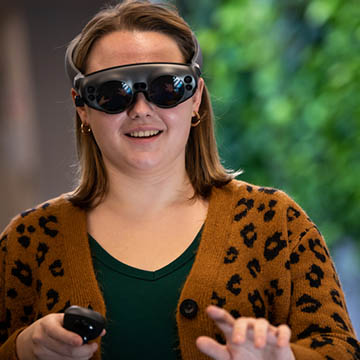The World-Builders
Chatham’s New Immersive Media Degree

Immersive Media
Chatham's Bachelor of Arts in Immersive Media (IMM) is the first program in the world of its kind: an undergraduate degree focused on creating content for augmented reality (AR) and virtual reality (VR) that goes beyond gaming, broadly covering other applications as well.
Located in Chatham Eastside, the immersive media studio is a large, cheery space. Like other studios, it has tables and chairs, and various pieces of equipment. Unlike other studios, one of those pieces of equipment is a flying machine, on which the participant lies face-down. “It’s a good workout for your abs,” notes Hunter Dyar, immersive media instructor and coordinator.
The studio is used by the students in Chatham’s new Bachelor of Arts in Immersive Media (IMM) program. Launched in 2019, it’s the first program in the world of its kind: an undergraduate degree focused on creating content for augmented reality (AR) and virtual reality (VR) that goes beyond gaming, broadly covering other applications as well.
When people think of virtual reality, they tend to think of games, and that's been the primary driver of the technologies. But it’s only the tip of the iceberg. Virtual reality can help a surgeon practice a surgery in advance, let students visit a museum half a world away, and allow military teams to practice working together in realistic environments.
Since the program’s first cohort of students is entering their second year, they’re not quite up to building those types of experiences, but what they have been building—even in their first year—is attracting attention—even outside the classroom.
Carson Custer ’23 built a VR game in which you use a giant hammer to hit big boxes that come flying at the player. He fabricated an actual gigantic foam hammer—six or seven feet long—with a giant foam head on it, and attached the controller to the hammer. “The project itself was very simple, but the design and implementation were incredibly novel,” said Assistant Professor of Practice for Immersive Media Douglas North Cook. “I shared a couple photos of me playing it on my Twitter account, and all these pretty big VR game developers were commenting ‘Oh my gosh, this is so cool, I need this hammer.’ Carson got to see these responses, and that was pretty incredible.”
Hitting boxes might sound whimsical, but for the final project, several students turned to the practical. “After we’d switched to fully remote teaching because of COVID,” says Cook, “some students just wanted to make a place to relax. So they made meditative or relaxation experiences that were specifically meant to help us all get through COVID. Which was a very sweet and darling response: ‘I’m going to pivot my final project and try to make something for me and my peers.’”
The IMM builds off of the strengths of Chatham’s interior architecture program, using design principles to create realistic spaces and make them accessible to as many people as possible. Many VR and AR experiences assume that the user will, for example, be able to stand up and move, have two hands to operate the controllers with, not have impaired vision. Given that that’s not always the case, the program is teaching students to keep this in mind. Students in the IMM program take a six-credit project-based studio course in accessibility and ethics, in which they build an AR or VR experience specifically through a lens of designing accessibility features, or designing features to solve for a specific issue, such as privacy or harassment.
The program draws students with a range of interests. Wayeera Robertson ‘22 got into the program because of her desire to mix art and physics. “Currently I’m minoring in physics,” she says, “and I want to take that and kind of mix everything around and see what kinds of things I can create. If I could show someone atoms and how they behave, but they’re in that space, experiencing it—I would like to create educational simulations like that.”
The program teaches a concrete set of skills, such using computer programming to create a 3D landscape, but the aptitudes that it develops are broad and would be welcomed by any employer: solving problems, thinking logically, working collaboratively.
Still, the technology part is a big deal. I ask Cook how the program teaches something that’s always changing, and always going to be changing.
Cook tells me that the underlying methodology and ways of approaching problems don’t change. Further, he says, “a lot of what we’re trying to do is look at other disciplines that have a deep and long history of designing experiences, objects, and environments. We’re looking at architectural history and theory; industrial and product design; fashion; psychology; and human anatomy. Really, a lot of the work that we’re doing is translating that work into our work. The other way we do it is by staying as current as possible in how things are changing, and sharing what we learn. It’s just part of the culture of the department—it takes all of us working together, exploring, and being curious.”
Augmented Reality vs. Virtual Reality
Augmented reality is inserting virtual content into real world spaces. For example, IKEA has an application where you can use the camera on your phone to scan a space, then “insert” a piece of IKEA furniture in that space to see how it looks.
Virtual reality is the creation of an entirely virtual space that surrounds you and often involves multiple senses.
How do you participate in VR?
To participate in VR, you most commonly need a headset with goggles, and VR controllers, which you operate with your hands. These come in different makes and models, and generally cost about $400.
The Bachelor of Arts in Immersive Media (IMM) is an interdisciplinary program that equips students with knowledge of virtual reality and augmented reality technology, architecture, 3D modeling, game development engines, writing, and design thinking to prepare them for careers in immersive media creation.
